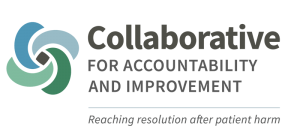Tools and Resources[ Show all or clear results ]
Journal Article
Published articles related to CRPTalking with Patients about Other Clinicians’ Errors
Published articles related to CRP
This article describes recommendations that extend existing guidelines for clinicians and institutions on communicating with patients about colleagues’ harmful errors.
Journal Article
Published articles related to CRPThe Disclosure Dilemma — Large-Scale Adverse Events
Published articles related to CRP
Large-scale adverse events are individual events or a series of related events that injured or increased the risk that many patients would be injured because of health care management. There are ethical reasons why institutions may hesitate to disclose large-scale adverse events to patients. Practical, legal, and financial considerations, such as the difficulty in predicting the likelihood of harm and identifying the injured patients, may also lead well-meaning institutions to consider not disclosing large-scale adverse events. This article discusses two ethical frameworks often used in determining whether to disclose large-scale adverse events: utilitarian and duty-based. It also describes three examples of large-scale adverse events and discuss their distinguishing features.
Book/Report
Reference to book or report
The Financial and Human Cost of Medical Error… and How Massachusetts Can Lead the Way on Patient Safety
Reference to book or report
This report from the Betsy Lehman Center details two sets of research findings and proposes a coordinated response through which Massachusetts’s providers, policymakers, and public can accelerate safety and quality improvement and lead the nation on this urgent health care challenge.
Learning Community
Resources associated with CAI Learning CommunityVideo
CRP related video, movieTHE ROLE OF THE DISCLOSURE COACH
Resources associated with CAI Learning Community
CRP related video, movie
Dr. Shapiro talks about the importance of having disclosure coaching program and fundamental principles of disclosure coaching. For more videos related to Disclosure and Apology, view the video gallery.
Journal Article
Published articles related to CRPThird Things as Inspiration and Artifact: A Multi-Stakeholder Qualitative Approach to Understand Patient and Family Emotions after Harmful Events
Published articles related to CRP
Patient and family emotional harm after medical errors may be profound. At an Agency for Healthcare Research and Quality (AHRQ) conference to establish a research agenda on this topic, the authors used visual images as a gateway to personal reflections among diverse stakeholders. Themes identified included chaos and turmoil, profound isolation, organizational denial, moral injury and betrayal, negative effects on families and communities, importance of relational skills, and healing effects of human connection. The exercise invited storytelling, enabled psychological safety, and fostered further collaborative discussion. The authors discuss implications for quality/safety, educational innovation, and qualitative research.
